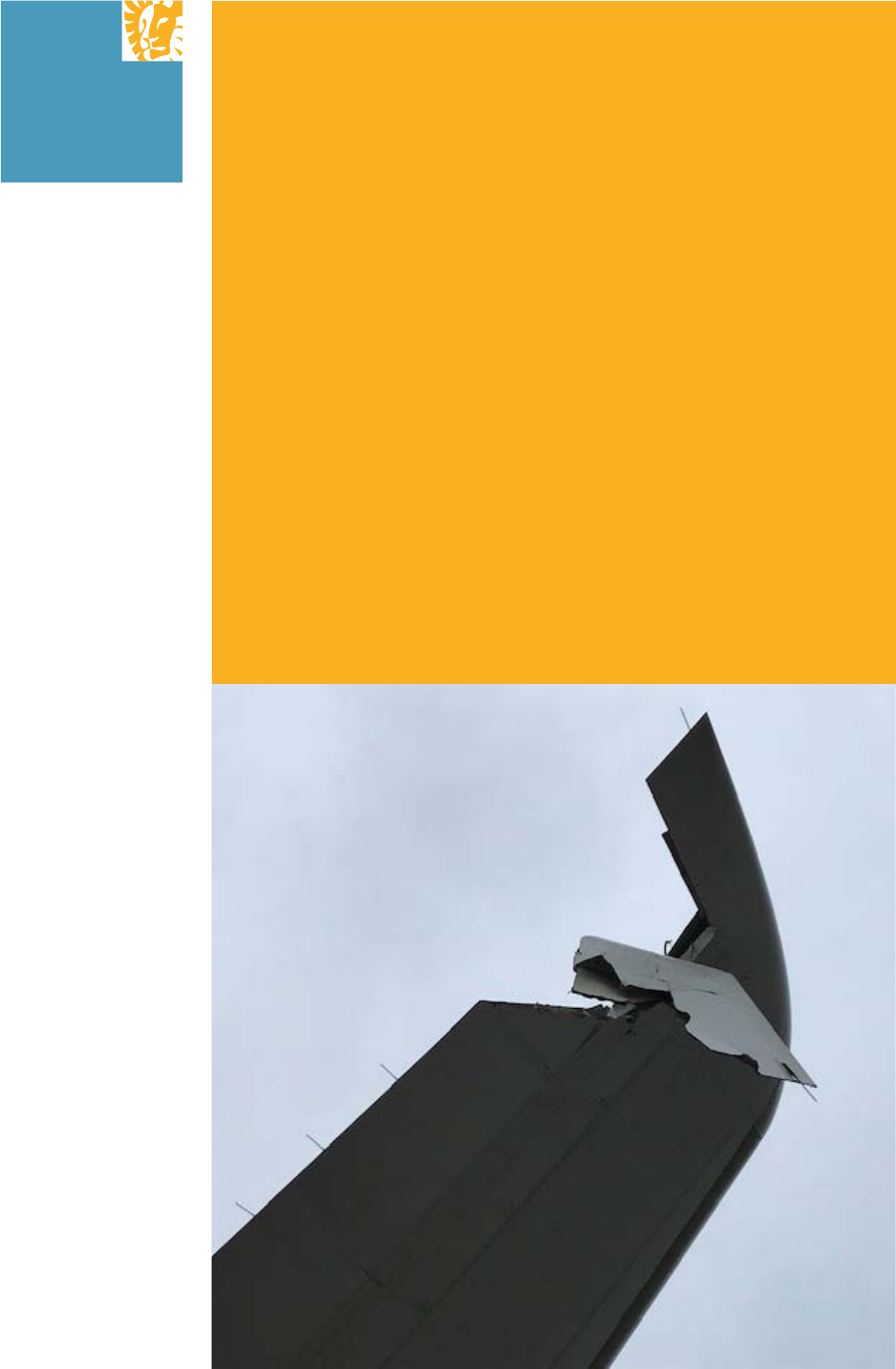
DUTCH
SAFETY BOARD
Collision during
pushback
The Hague, March 2022
The reports issued by the Dutch Safety Board are publicly available on www.safetyboard.nl.
Source cover photo: Amsterdam Airport Schiphol
Collision during
pushback
- 3 -
The Dutch Safety Board
When accidents or disasters happen, the Dutch Safety Board investigates how it was
possible for these to occur, with the aim of learning lessons for the future and, ultimately,
improving safety in the Netherlands. The Safety Board is independent and is free to
decide which incidents to investigate. In particular, it focuses on situations in which
people’s personal safety is dependent on third parties, such as the government or
companies. In certain cases the Board is under an obligation to carry out an investigation.
Its investigations do not address issues of blame or liability.
Dutch Safety Board
Chairman: J.R.V.A. Dijsselbloem
S. Zouridis
E.A. Bakkum
Secretary Director: C.A .J.F. Verheij
Visiting address: Lange Voorhout 9
2514 EA The Hague
The Netherlands
Postal address: PO Box 95404
2509 CK The Hague
The Netherlands
Telephone: +31 (0)70 333 7000
Website: safetyboard.nl
E-mail: info@safetyboard.nl
N.B: This report is published in English, a summary is available in the Dutch language. If
there is a difference in interpretation between the Dutch and English versions, the English
text will prevail.

- 4 -
CONTENTS
Summary �������������������������������������������������������������������������������������������������������������������� 5
Abbreviations ������������������������������������������������������������������������������������������������������������� 7
General overview ������������������������������������������������������������������������������������������������������� 8
1 Factual information ����������������������������������������������������������������������������������������������� 9
1.1 General ................................................................................................................ 9
1.2 History of the flight ............................................................................................... 9
1.3 Injuries to persons .............................................................................................. 12
1.4 Damage to aircraft .............................................................................................. 12
1.5 Procedures .......................................................................................................... 12
1.6 Cockpit Voice Recorder ...................................................................................... 15
1.7 Other investigations ........................................................................................... 16
2 Analysis ����������������������������������������������������������������������������������������������������������������17
2.1 Long pushback ................................................................................................... 17
2.2 Procedures .......................................................................................................... 18
2.3 Communications ................................................................................................. 18
2.4 ISMS investigation results and follow-up actions ............................................... 19
2.5 CVR recordings ................................................................................................... 21
3 Conclusions �������������������������������������������������������������������������������������������������������� 23
Appendix A Responses to the draft report ������������������������������������������������������������� 24

- 5 -
SUMMARY
On 13 February 2019, during pushback at Amsterdam Airport Schiphol, a Boeing 747-400
(hereafter: B747) collided with a Boeing 787-9 (hereafter: B787) standing on the taxiway
before taxiing out.
Ground Control had issued a long pushback clearance to the B787. The flight crew
passed this clearance on to the pushback driver. The driver positioned the B787
approximately 20 meters beyond the pushback limit line on the taxiway. Shortly after, a
B747 also received clearance to commence pushback. Following his pushback clearance
to the B747, the ground controller realised that this pushback would possibly bring the
B747 close to the B787, so he issued a cautionary message to the B747 flight crew. The
transmission of this message was partially blocked out by another transmission. There
was no readback of the message by the flight crew of the B747, and the ground controller
did not act on the missing readback. As a result, the message was not forwarded to the
B747 pushback truck driver. The pushback truck driver of the B747 was not aware of the
long pushback of the B787. From his position, he could not determine the exact position
of this aircraft on the manoeuvring area and during the push his view on the B787 was
obstructed by the engines of the B747.
Ground control has the overview of the clearances issued and the positions of the aircraft
on the apron and taxiways. The undocumented long pushback procedure used in this
accident was not an assessed and aligned procedure within the sector parties at Schiphol.
The non-standard pushback of the B787 introduced non-standard conditions the
pushback truck driver of the B747 was not aware of. Deviating from standard procedures
is not an uncommon practice for air traffic controllers at Schiphol, as was also noted in
previous investigations of the Dutch Safety Board, such as the 2017 Schiphol investigation.
The reason for deviating from the standard pushback procedure was to ensure an
efficient flow of traffic. This deviation, however, introduced risks as separation margins
were no longer ensured. The non-standard pushback of the B787 implied a temporary
restriction of other traffic in its vicinity. The mitigation action implemented by the ground
controller – issuance of a cautionary message – was not effective, as the transmission of
this message was blocked. The assessment of the taxiway behind the aircraft and the
issuance of conflict-free pushback clearances is the responsibility of Ground Control and
cannot be delegated to a pushback truck driver. A pushback clearance should only be
issued when adequate separation can be guaranteed.
The use of standard pushback procedures with known obstacle clearances and separation
margins is the main barrier to ensure sufficient clearance in pushback operations. It is
therefore essential that in case of deviations from the standard procedure, the risks are
recognized and mitigating actions are put in place effectively. As a result, in case of
- 6 -
deviations from standard procedures, it may be necessary to temporarily stop other
traffic movements.
Following the pushback accident, the sector parties decided to conduct a joint
investigation in the context of the Integral Safety Management System (ISMS). The ISMS
investigation has identified relevant safety issues. The working practice of a long
pushback procedure has been amended by Air Traffic Control the Netherlands (LVNL)
and only clearances with a specific end position shall be issued by the ground controller.
Although providing more clarity, this working practice whereby separation margins may
no longer be guaranteed is still being used. This introduces complexities and safety risks
as it is not an assessed procedure. It is uncertain to what extent a set of additionally
safety measures identified by the sector parties will contribute to a further risk reduction
of pushback collisions, as for the majority of these measures further study or technological
development is needed.
This investigation further showed that the operator’s procedures were not effective in
preserving the Cockpit Voice Recorder (CVR) recordings of one of the aircraft involved,
which is an obligation in case of an accident or serious incident for the purpose of the
safety investigation. An extention of the regulatory requirement regarding the minimum
recording duration of the CVR has already been recognized by aviation regulators as a
necessary safety improvement.

- 7 -
ABBREVIATIONS
AAS Amsterdam Airport Schiphol
AHM-GEN Aircraft Handling Manual – General
AIP Aeronautical Information Publication
ATC Air Traffic Control
CVR Cockpit Voice Recorder
ISMS Integral Safety Management System
LVNL Air Traffic Control The Netherlands (in Dutch: Luchtverkeersleiding
Nederland)
TOPSAG Top Safety Action Group
TWR-APP Tower - Approach
UTC Coordinated Universal Time
VNV Dutch Airline Pilots Association (in Dutch: Vereniging Nederlandse
Verkeersvliegers)
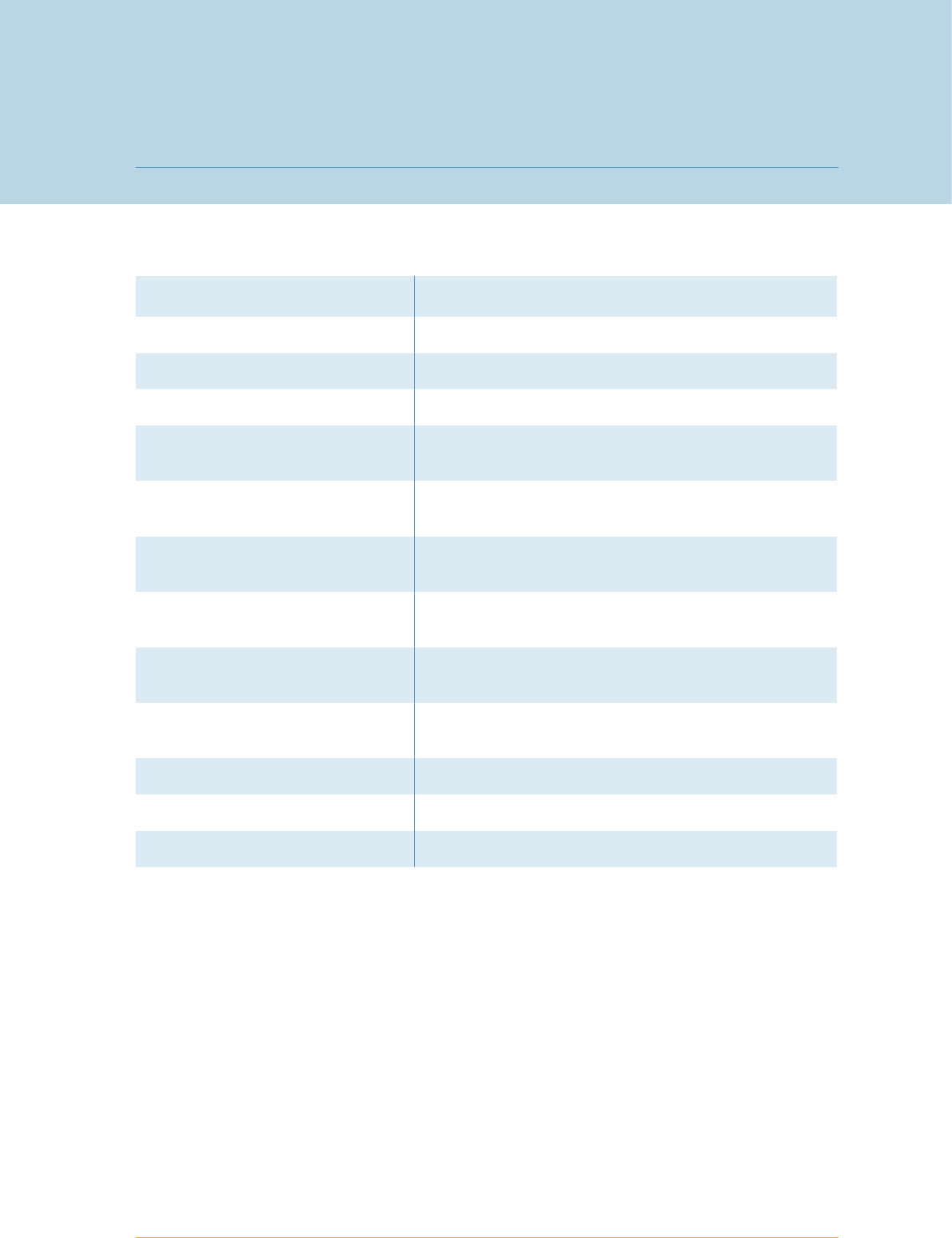
- 8 -
GENERAL OVERVIEW
Identification number: 2019009
Classification: Accident
Date, time of occurrence: 13 February 2019, 09.51 hours
1
Location of occurrence: Amsterdam Airport Schiphol
Registration:
1. PH-BFV
2. PH-BHA
Aircraft type:
1. Boeing 747-400
2. Boeing 787-9
Aircraft category:
1. Commercial – fixed wing
2. Commercial – fixed wing
Type of flight: 1. Commercial Air Transport (scheduled passenger flight)
2. Commercial Air Transport (scheduled passenger flight)
Phase of operation: 1. Pushback
2. Shortly before commencing taxi
Damage to aircraft: 1. Minor
2. Substantial
Injuries: None
Other damage: None
Light conditions: Daylight
1 All times in this report are local times (UTC + 1 hours), unless otherwise specified.

- 9 -
1 FACTUAL INFORMATION
1�1 General
On 13 February 2019, during pushback at Amsterdam Airport Schiphol, a Boeing 747-400
(hereafter: B747) collided with a Boeing 787-9 (hereafter: B787) resulting in substantial
damage. The occurrence is classified as an accident. In accordance with Regulation (EU)
No 996/2010 on the investigation and prevention of accidents and incidents in civil
aviation, the Dutch Safety Board has the obligation to conduct a safety investigation.
The following key questions were investigated:
• What led to the pushback of the B747, while another aircraft was standing on the
taxiway beyond its pushback limit line?
• To what extent did the applicable procedures cover a long pushback clearance?
• To what extent was the communication between the ground controller, the flight
crews and the truck drivers effective for the tasks they had to perform?
Two days after the accident, the operator informed the Dutch Safety Board that the
sector parties
2
would conduct a joint investigation in the context of the Integral Safety
Management System (ISMS).
3
1�2 History of the flight
On 13 February 2019, around 09.51 hours local time on Amsterdam Airport Schiphol
(hereafter: Schiphol), a B747 collided during pushback with a B787 that was standing on
the taxiway getting ready to start taxiing.
The B787 was initially parked at gate F08. Due to a delay during boarding, the pushback
clearance issued by Ground Control was received around 15 minutes after the scheduled
departure time. Just after the pushback clearance readback
4
by the flight crew, the
ground controller amended the clearance, instructing the B787 flight crew to make the
push long enough to allow an arriving aircraft to dock at gate F08. The flight crew passed
this clearance on to the pushback truck driver, as truck drivers at Schiphol have no means
2 KLM, Air Traffic Control The Netherlands (LVNL), Amsterdam Airport Schiphol (AAS), Dutch Airline Pilots
Association (VNV).
3 See paragraph 1.7 for further details.
4 Readback is a procedure whereby the receiving station repeats a received message or an appropriate part thereof
back to the transmitting station so as to obtain confirmation of correct reception (ICAO Annex 10).

- 10 -
of direct communication with Ground Control. The pushback truck driver positioned the
B787 approximately 20 meters beyond the pushback limit line on taxiway A16.
5
A pushback limit line is a marking on the taxiway for use by pushback truck drivers
pushing back an aircraft from a stand. The purpose of a pushback limit line is to
indicate the maximum movement of the aircraft. A pushback limit line is designed to
provide clearance between aircraft and fixed objects, aircraft on stands and taxiing
aircraft on adjacent taxiways. When diverting from a pushback limit line, for example
positioning the aircraft beyond the limit line, clearance is no longer guaranteed.
After the pushback procedure was completed, the B787 received clearance to taxi to the
runway, by joining taxiway A after another aircraft had passed. At that time, a B747
standing at gate E07 received clearance to commence pushback from the gate onto
taxiway A14 and to pull out
6
after the B787. The flight crew of the B747 passed the
clearance to commence pushback to their pushback truck driver. The pushback truck
driver of the B747 acknowledged to the flight crew and started the pushback.
Following his pushback clearance to the B747, the ground controller realised that the
pushback would possibly bring the B747 close to the B787, and he issued a cautionary
message to the B747 flight crew, asking them to inform their ground crew that the B787
had made a longer push than normal. The transmission of this latter message was partially
blocked out by another transmission. There was no readback of the message by the
flight crew of the B747, and the message was not forwarded to the B747 pushback truck
driver. The ground controller did not act on the missing readback.
The pushback truck driver of the B747 pushed the aircraft onto taxiway A14, resulting in a
collision between the two aircraft (see Figure 1). The right-hand wingtip of the B747
collided with the right horizontal stabiliser of the B787, resulting in damage to both
aircraft.
The B747 pushback truck driver stated that he did see the B787 on the taxiway, but could
not determine how the aircraft was positioned relative to its pushback limit line. He
stated he was not aware of the long pushback of the B787 and that during the B747
pushback the engines of the B747 obstructed his view of the right side of the aircraft.
During the pushback of the B747, the pushback truck driver of the B787, who was
disconnected already from the B787 but waiting for the aircraft to start rolling, did see
that a collision was imminent, but was unable to act due to the quickly evolving situation
as he was standing on the aircraft stand.
5 The pushback limit line at F08 on taxiway A16 provides the required separation margin for another aircraft to dock
at that gate. However, this separation margin is estimated by some crews as inadequate. A long pushback provides
more margin for the arriving aircraft and avoids the situation where the crew of the inbound aircraft might stop the
docking manoeuvre and block a taxiway. (Source: ISMS investigation)
6 A push-pull is a pushback procedure where an aircraft has to be pulled forward after pushing backwards.
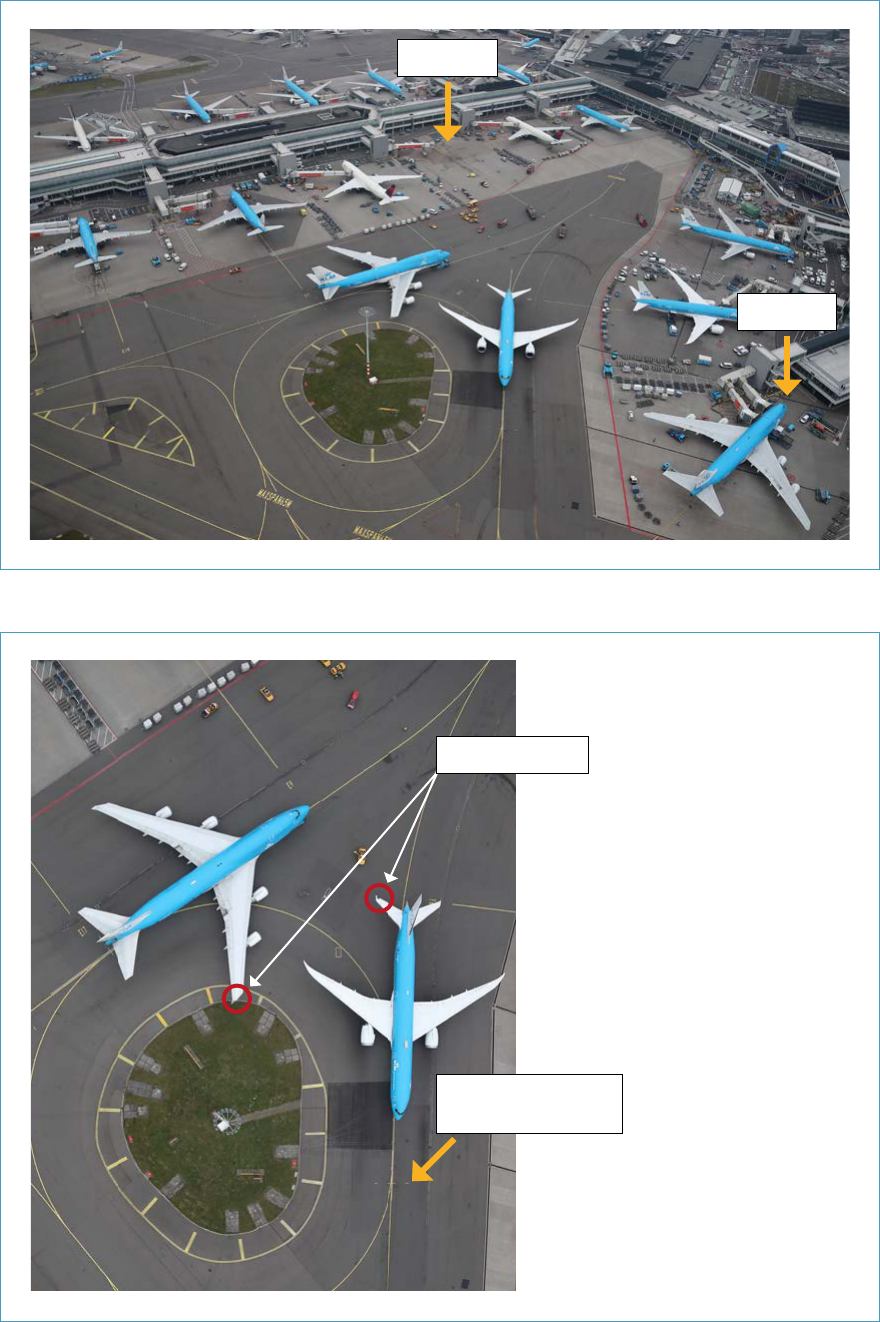
- 11 -
Figure 1: Aircraft positions after the accident. (Source: Dutch aviation police)
Figure 2: Top view of the position of the aircraft after the accident. (Source: Dutch aviation police)
Gate E07
B747
B787
Taxiway A16
Taxiway A14
Gate F08
Pushback limit line
for gate F08
Damaged parts

- 12 -
1�3 Injuries to persons
There were no injuries to the flight crew, cabin crew or passengers.
1�4 Damage to aircraft
The B787’s right horizontal stabiliser was substantially damaged (see Figure 3a), requiring
a major repair according to the operator. The B747’s right wingtip (winglet) was damaged
(see Figure 3b), assessed to require a minor repair according to the operator.
1�5 Procedures
1.5.1 Aerodrome
The accident occurred in the northern area of the airport, in the EF-bay which is
connected to taxiway A. Amsterdam Airport Schiphol has standard pushback procedures
in the form of a general standard pushback directions chart
7
, and procedures per stand.
The standard pushback directions chart for taxiways A16 and A14, as applicable at the
time of the accident, are depicted in Figure 4.
The B787 was parked at gate F08. The standard pushback direction onto taxiway A16
from the perspective of the pushback truck driver is right (see Figure 5). The B747 was
parked at E07. The standard pushback direction from E07 onto taxiway A14 is right (see
Figure 6). For E07 it is noted on the pushback chart that, after pushback, aircraft of
category 5 and higher
8
(which includes the Boeing 747-400), should be pulled onto
taxiway A16 (i.e. a push-pull procedure).
7 In Dutch: Standaard Pushbackrichting, see www.schiphol.nl/pushback
8 Amsterdam Airport Schiphol established an aircraft categorisation based on the dimensions, ranging from
category 1 (small) to category 9 (large). A Boeing 787-9 is categorised as category 7 and a Boeing 747-400 as
category 8 aircraft.
Figure 3a: Damage to the B787’s right horizontal
stabiliser. (Source: Amsterdam Airport Schiphol)
Figure 3b: Damage to the B747’s right wingtip.
(Source: Amsterdam Airport Schiphol)
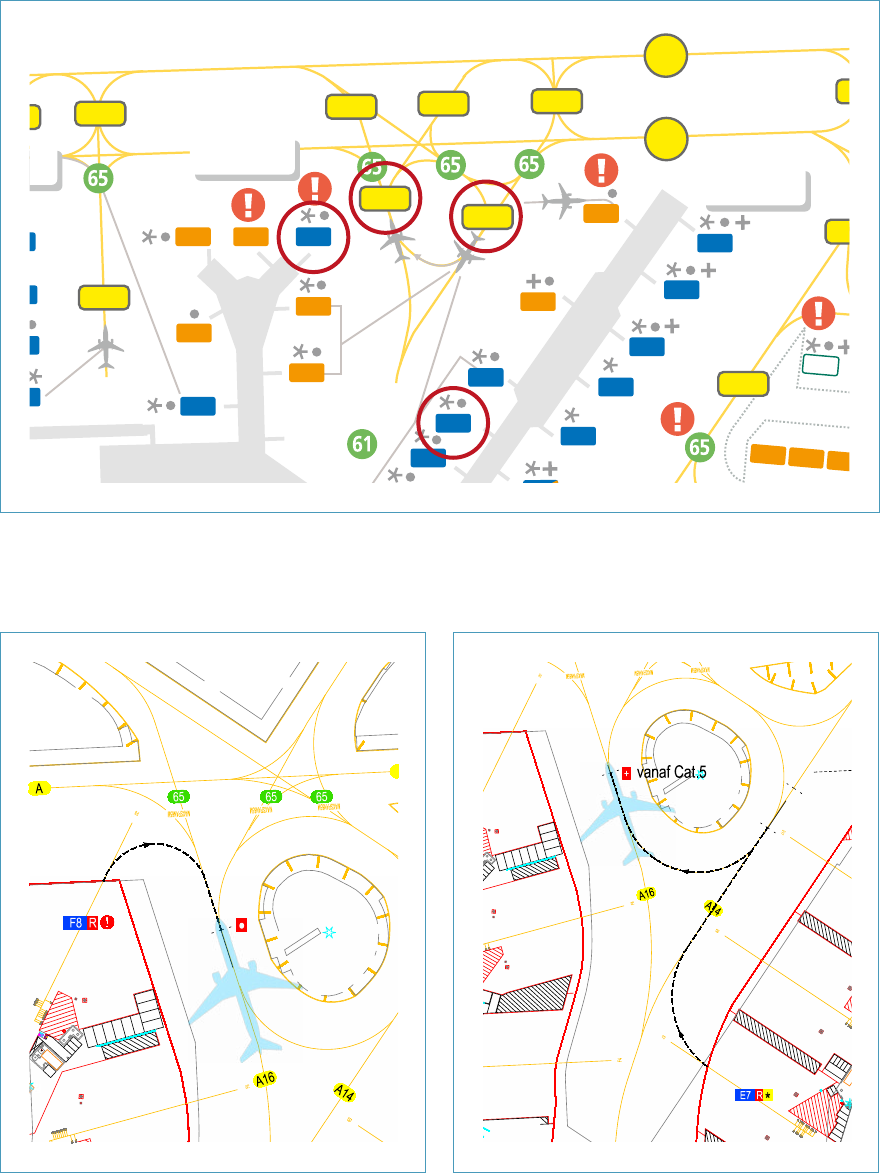
- 13 -
On the taxiways, pushback limit lines are marked in white. The airport’s procedures also
define an alternative pushback procedure and state that only Ground Control may decide
a deviation from the standard pushback.
Figure 4: Standard pushback directions (blue=right; orange=left; *=remarks apply). Red circles for F8, E7, A14
and A16 added. (Source: Amsterdam Airport Schiphol)
R 72
R 71
R 73
R 82
R 81
R 80
R 77
R 74
R 83
S 72
S 84
S 82
S 79
S 77
S 74
S 87
S 90
S 92
0 40 4
2 22 2
0 60 6
2 42 4
S 96
S 94
K 15
K 14
K 13
K 12
K 11
K 16
K 24
K 23
K 22
K 21
K 20
K 25
K 26
K 27
K 41
K 42
K 43
K 44
K 40
K 74
K 73
K 72
K 71
K 38
K 37
K 36
K 35
K 39
M62
N042
N041
M61
M63
M66
M65
M67
M70
M69
M71
M74
M73
M75
M81
M84
M83
M85
M88
M87
M89
M92
M91
M93
M77
M79
P 21
P 20
G 5
G 7
G 3
G 9
G 2
G 4
G 8
G 6
G 79
G 71
G 73
G 76
J 80
F 3
F 5
F 7 F 9 F 8
E 24
E 22
E 20
E 19
E 17
E 9
E 3
E 5
E 7
E 18
E 8
E 6
E 4
E 2
C 4
C 6
C 8
C 10
C 12
C 5
C 7
C 9
C 11
C 14 C 16
C 18
C 13
H 7
H 6
H 5
H 4
H 3
H 2
H 1
P D
P C
P B
P A
P 3
P 1
P 2
E 75
E 72
E 77
D 88
D 90
D
92
D 94
D 93
Y 71
Y 73
A
A24
A22
B
A20
A 21
B
A16
A17
A18
A16
A14
A15
A14
A
B
A
B
A
A11
B
A
A13
A12
A13
A12
A10
A10
A4
A8
A5
A6
A7
A
B
A4W
A4E
A17
Q
A25
A26
J 81
J 82
J 83
J 84
J 85
J 86
J 87
P 10
P 11
A 4
D 47
D 57
D 49
D 51
D 55
D 53
D 47
D 57
D 49
D 51
D 55
D 53
D 56
D 48
D 52
D16
D 28
D18
D 22
D 26
D 24
D 23
D 27
D 31
D 7
D 5
D 3
D 43
D 41
D 2
D 4
D 10
D 12
D 14
D 95
A13
G-PLATFORM
J-PLATFORM
D/E PLATFORM
D-PIER
E-PIER
F-PIER
B-PIER
C-PIER
A6
A5
A8
A5
A19 E
A19 C
A19 W
A19 W
H-PIER
Y-PLATFORM
P 12
P 13
P 14
C 15
B28
B31
B24
B20
B35
B27
B15
B23
B17
B13
B32
B36
B16
P 16
P 15
A9C
D 44
D 54
D 25
D 29
A9
U-PLATFORM
A
B
D
A8
F 6
F 4
A19 E
G-PIER
A 25
U 20
U18
U16
U 28
U 29
U 21
U 30
U 23
U 26
U 32
U17
U15
U13
U14
U12
U10
U11
C
U10 T/M U18
IN MAART 2020
OPERATIONEEL
61
61
61
61
Taxi-in/Out
Rechts
Links
Links óf rechts,
zie bijzonderheden standaard pushbacks
Achteruit
Nose out parkeren
Tow-in /Out
Pushback limit line
Push-pull
Zie bijzonderheden
standaard pushbacks
Zie bijzonderheden
infrastructuur
Rijbaanbenamingen
Max. spanwijdte
Scheiding Apron noord / zuid
Taxi-in/Out
Rechts
Links
Links óf rechts,
zie bijzonderheden standaard pushbacks
Achteruit
Nose out parkeren
Tow-in /Out
Pushback limit line
Push-pull
Zie bijzonderheden
standaard pushbacks
Zie bijzonderheden
infrastructuur
Rijbaanbenamingen
Max. spanwijdte
Scheiding Apron noord / zuid
A
A3
G
G5
A3
A3
A2
A2
R
S1
A
B
S2
Q
S2
G1
G2
NOORD
ZUID
G
G
S8
S
S
A1A
A1B
A1C
GD
GL
44
R 87
29
A 35
A 34
A 33
A 32
A 31
A 72
A 73
A 74
A 71
A 75
B 82
B 83
B 84
B 81
B 85
B 92
B 93
B 94
B 91
B 95
A 42
A 43
A 44
A 41
A 45
A 46
A 52
A 53
A 54
A 51
A 55
A 56
A 62
A 64
A 61
A 65
A 63
LET OP:
PLATFORM IN ONTWIKKELING!
M-PLATFORM
S-PLATFORM
K-PLATFORM
R-PLATFORM
REGIONALS PLATFORM
B-PIER
Bzonderheden standaard pushbacks
C5, C7, C9: B757-200/300 pushback t.h.v. C11 standaard via rbaan A5
D2, D4: t/m. cat. 4 pushback t.h.v. C7, vanaf cat. 5 pushback t.h.v. C11 standaard
via rbaan A5
D14: pushback limitline t.h.v. D12
D3, D5, E2: pushback op rbaan A10 t.h.v. D47
D7, D43, E6 t/m. cat. 4 push-pull t.h.v. E06,
vanaf cat. 5 pushback op rbaan A10 t.h.v. D47
E3, E5, E7, E9, F4, F6: t/m. cat. 4 pushback op rbaan A14,
vanaf cat. 5 push-pull op rbaan A16
E8, E18: vanaf cat. 5 push-pull t.h.v. E20
E20, E22, E24: push-pull op rbaan A12 t.h.v. E77
E72: Pushback recht achteruit, Pull op rbaan A12 t.h.v. E77
F3: pushback op rbaan A vr van rbaan A18
F7: pushback op pushback limitline op A17
F8: pushback op rbaan A16 vr van rbaan A
G2: push-pull t.h.v. G4
G4: vanaf cat. 6 push-pull t.h.v. G6
G3: t/m. cat. 4 pushback op A19E, pull t.h.v G5. Vanaf cat. 5 push op push-pull
limitline met markering PP cat. 5 – 8, vervolgens pull op A19C t.h.v. G9
G5, G7: t/m. cat. 4 pushback op A19E. Vanaf cat. 5 push-pull op A19C t.h.v. G9
G73, G76: t/m. cat. 4 pushback op A19W. Vanaf cat. 5 push-pull op A19C t.h.v. G9
G9: t/m. cat. 4 pushback op A19E. Vanaf cat. 5 pushback limitline op A19C
G79: t/m. cat. 4 pushback op A19W. Vanaf cat. 5 pushback limitline op A19C
J80 t/m. J87 en P10 t/m. P16: push-pull t.h.v. J80
S72 t/m. S96: pushback facing S2 of facing S8 afhankelk van baangebruik.
Sleepverkeer pushback rechtsom
Cat. Meest voorkomende vliegtuigtypes op Schiphol
1
Do328, EMB120, Saab340. Alle vliegtuigen tot wingspan 24m
2
ATR42/72, CRJ100/200, EMB135, Saab 2000
3
B737-300 t/m. B737-500, BAe146-200/300, CRJ700-900, Q400, EMB145, EMB170
t/m. 190, F100
4
A318 t/m. A321, B737-300W, B737-500W, B737-600 t/m. B737-900, B737MAX8
t/m. 10, CRJ1000, A220-100/300, EMB195
5
A310-300, B757-200
6
A300-600, B757-300, B767-300(ER)
7
A330-200/300, A340-300, B767-400, B777-200(ER), B787-8 t/m. 10
8
A340-600, A350-900/1000, B747-400, B777-200LR/300(ER), A330-900
9
A380, AN124, B747-8F
Bzonderheden infrastructuur:
B13: pushback komt in klaring rbaan A4E
C4: pushback komt in klaring rbaan A4W
C16: pushback komt in klaring rbaan A
D28: pushback komt in klaring rbaan A
E18: Let op pushback A380 niet verder dan E08 i.v.m. max wingspan 65m
E19: gebruik de guidance line met de vliegtuigtrekker voor voldoende klaring
t.o.v. rbaan A
E72: pushback / ink. sleep komt in klaring rbaan A13
E75: pushback komt in klaring rbaan A13
E77: pushback / ink. sleep komt in klaring rbaan A
F8: pushback komt in klaring rbaan A
F9: alt. pushback rechtsom komt in klaring rbaan A16
G9: Let op pushback A380 niet verder dan G5 i.v.m. max wingspan 65m
G71: b gebruik van push & hold: H1 t/m. H7 pushback via rbaan A19W
naar VOP G71 nose out
J80 t/m. J87,
P10 t/m. P16:
Pushback klaring
te geven door
Apron Control
Figure 5: Pushback procedure F08. (Source:
Amsterdam Airport Schiphol)
Figure 6: Pushback procedure E07 for category 5
aircraft and higher. (Source: Amsterdam Airport
Schiphol)
B
F8
A/OPS/AO
F8: push-back op rijbaan A16 komt in klaring rijbaan A
B
B
BTS
BTS
KL
KL
BTS
KL
PCA
PCA
B
B
PCA
E7 vanaf Cat. 5
A/OPS/AO
E7 vanaf cat. 5 push-pull op rijbaan A16

- 14 -
1.5.2 Ground control
The Air Traffic Control (ATC) unit involved was Luchtverkeersleiding Nederland
9
(LVNL)
Schiphol Tower. Ground Control is responsible for air traffic control on the manoeuvring
area, with the exception of active runways. At the time of the accident there was one
ground controller with Schiphol North as area of responsibility on duty. From his working
position at Schiphol Tower, both taxiways A14 and A16 and gates F08 and E07 were
visible.
The ground controller issues the clearance for the pushback to the flight crew. Following
the clearance, a standard pushback (up to the pushback limit line) is performed. The
LVNL’s Schiphol Tower-Approach (TWR-APP) operations manual states that when
necessary the ground controller may instruct an alternative pushback clearance. In case
of such an alternative pushback, the procedure states that the ground controller shall
indicate a direction and/or position where the aircraft is to be positioned.
10
A long pushback is understood to be a variant of the alternative pushback, with in this
case the aircraft being positioned several meters behind the pushback limit line, but its
exact position is left to the discretion of the pushback truck driver.
1.5.3 Pushback
Both involved pushback truck drivers were employed by the same organisation; the
towing department of the operator involved.
The organisation’s Aircraft Handling Manual – General (AHM-GEN) and type-specific
manuals for the B747 and B787 describe the pushback procedures for the truck drivers.
Work instructions are published based on these procedures, describing the process of
positioning the aircraft for departure through a pushback/push-pull to the indicated
pushback limit line.
11
Charts published by the aerodrome indicate the applicable standard
pushback directions.
The pushback process starts at the instant the flight crew receives the pushback clearance
from Ground Control. The flight crew passes the clearance to the pushback truck driver,
see figure 7. The pushback truck driver has to wait the authorization of the flight crew
before moving the aircraft.
The minimum number of ground staff required for a pushback with a towbarless tug is
one pushback truck driver. The driver is responsible for the onset of the pushback
procedure and the communication with the flight crew. Pushback truck drivers are
obliged to listen to the relevant aerodrome’s Apron Control radio frequency (in this case
Apron-North)
12
. They have no access to the LVNL’s Ground Control frequencies.
9 Air Traffic Control the Netherlands.
10 Operations Manual LVNL, Start-up and push-back, 31 January 2019.
11 Instruction WPI KN Pushback: Het gereedzetten van het vliegtuig voor vertrek middels pushback/push-pull naar
de aangegeven pushback-limitline.
12 Apron Control is responsible for the control of tow movements. This task has been delegated by LVNL to
Amsterdam Airport Schiphol.

- 15 -
Figure 7: Communication schematic Pushback clearance.
In the AHM-GEN it is further stated that “additional ground staff may be present (as wing
walker or lookout) if required
13
or on request of the pushback truck driver, to safeguard
the rear movement of the aircraft and to ensure safe clearance to prevent collision”. The
truck drivers involved indicated that in practice this option is seldomly used.
1�6 Cockpit Voice Recorder
Commercial aircraft are equipped with a Cockpit Voice Recorder (CVR) that records
communications and sounds in the cockpit. This information can be used by safety
investigation authorities to reconstruct occurrences. In accordance with requirement
CAT.GEN.MPA.105 of Regulation (EU) No 965/2012 on Air Operations, in the event of an
accident or serious incident the pilot-in-command is responsible to deactivate the flight
recorders immediately after the flight in order to preserve the data of the occurrence.
The operator’s Basic Operations Manual (BOM) describes how the crew and commander
should act in case of an incident, serious incident or accident. It is stated that the
commander shall ensure that in the event of an (serious) incident or accident that is
subject to mandatory reporting, the flight recorders are not intentionally erased, are
deactivated immediately after the flight is completed, and are reactivated only with the
agreement of the investing authority.
The CVR recordings of the B747 were available for the investigation. However, the CVR
recordings of the B787, which had a duration of 2 hours, was not secured on time by the
operator after the occurrence of the accident. This led to the recording of the CVR data
of the accident being overwritten.
At the time of this report, the Dutch Safety Board is conducting two other investigations
where the CVR-recordings are not available. Also in the report ‘Take-off from Taxiway’
published in 2011, the Dutch Safety Board noted that the absence of CVR data for the
purpose of the investigation a great deficiency. The three occurrences mentioned all
involved Dutch airlines, of which two occurred with the operator involved in this pushback
accident.
13 No further details are provided regarding in what situation this is required.
Ground
controller
Flight crew Truck driver
clearance permission
readback readback

- 16 -
An extention of the regulatory requirement regarding the minimum recording duration
of the CVR has already been recognized by aviation regulators as a necessary safety
improvement. Current European legislation requires that for commercial air transport
operations with aeroplanes of a maximum certificated take-off weight of more than
27,000 kg and first issued with an individual certificate of airworthiness on or after 1
January 2022, the CVR shall be capable of retaining the data recorded during at least the
preceding 25 hours.
14
1�7 Other investigations
In April 2017, the Dutch Safety Board published the report of its investigation into air
traffic safety at Amsterdam Airport Schiphol
15
(Schiphol investigation). This report
concluded regarding air traffic control operations amongst others that:
• Schiphol is a complex airport, both in terms of infrastructure and in terms of how air
traffic is handled.
• LVNL regularly deviates from standard procedures and routines, mainly to ensure
efficient flow of traffic and to deal with disturbances. Deviating from standards and
routines can lead to additional complexity and introduction of risks.
• Air traffic controllers need a certain professional space for decision-making in non-
standard situations. This requires a clear framework to guarantee safety.
• The role and responsibility of LVNL is very important for guaranteeing safety at
Schiphol Airport. At the same time, LVNL is co-responsible for the efficient flow of
traffic. This places the LVNL in a position where complex assessments have to be
made all the time.
The Dutch Safety Board issued several recommendations in his investigation report. One
of the recommendations was that Amsterdam Airport Schiphol, LVNL and airlines should
set up an integrated Safety Management System. Such a system should at least include a
joint approach to the safety risks associated with the interactions between the individual
parties, joint investigations of incidents and joint proactive safety analyses. Following this
recommendation, the sector parties involved have set up an Integral Safety Management
System (ISMS).
Following the pushback accident, the sector parties decided to conduct a joint
investigation in the context of the ISMS. The investigation results and follow-up actions
are presented in paragraph 2.4.
14 Commission Implementing Regulation (EU) 2020/2036 of 9 December 2020.
15 Dutch Safety Board, Veiligheid vliegverkeer Schiphol, April 2017 (In Dutch; English summary available on the
Board’s website).

- 17 -
2 ANALYSIS
This chapter analyses the collision, the effectiveness of pushback procedures, pushback
communications, and concludes with a reflection on the ISMS-investigation results and
follow-up actions by the sector parties. Additionally, it addresses the securing of Cockpit
Voice Recorder information.
2�1 Long pushback
On the day of the accident, the departure of the B787 from gate F08 was delayed. As the
incoming traffic for F08 was already approaching on the taxiway, the ground controller
issued a clearance for a long pushback. This way, an arriving aircraft could dock in front
of the B787 at gate F08 unhampered. The ‘long pushback’ clearance left the exact
positioning of the B787 to the discretion of the pushback truck driver. In this case the
aircraft was placed some 20 meters behind the gate’s pushback limit line. The obstacle
clearances obtained by positioning the aircraft at the pushback limit line were therefore
no longer ensured.
Shortly after the push of the B787, the truck driver at gate E07 performed a standard
B747 pushback. This truck driver was not informed by Ground Control (through the flight
crew) of the long pushback of the B787, as the transmission of the ground controller’s
message to the flight crew of the longer push of the B787 was partially blocked out by
another transmission. Therefore, when the truck driver received permission to pushback,
he could not suspect there would be an aircraft within collision distance from the B747.
The truck driver did see the B787 on the taxiway. In case he would have been informed
about the long pushback, from his position in the truck his view would most probably still
have been obstructed by the B747’s engine cowlings. This would still prevent him to
sufficiently determine how the B787 was positioned relative to its pushback limit line and
monitor the clearances.
As the B787 was positioned behind the pushback limit line, as a reaction to the long
pushback clearance issued by Ground Control, the separation margins were no
longer ensured.
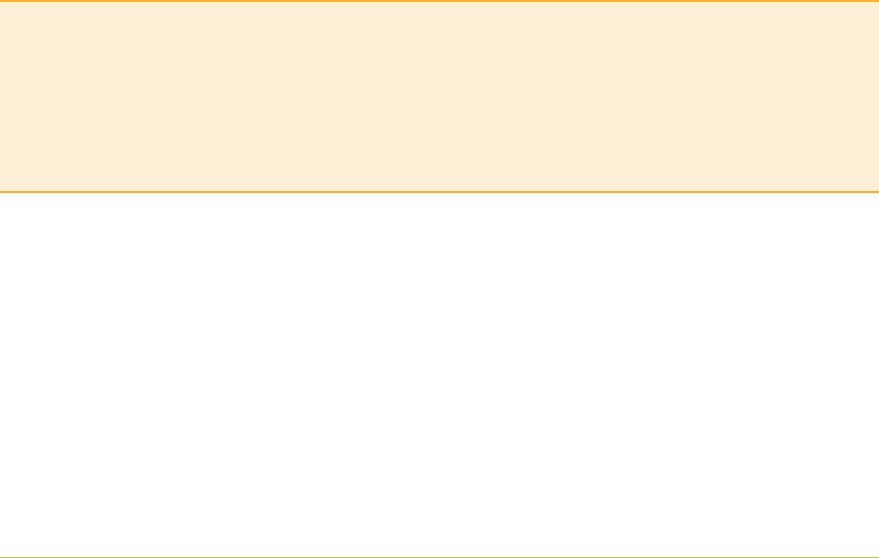
- 18 -
2�2 Procedures
A ‘long pushback’ is considered by Air Traffic Control to be a variant of an alternative
pushback. The long pushback clearance issued by the ground controller for the B787 did
not specify a specific position or point of reference, which left the positioning of the
aircraft to the pushback truck driver. Consequently, the barrier for safeguarding conflict-
free execution of simultaneous pushbacks had been taken away.
Deviating from standard procedures is not an uncommon practice for air traffic controllers
at Schiphol, as was amongst others also noted in the Dutch Safety Board’s 2017 Schiphol
investigation (see also paragraph 1.7). In the report of that investigation it is stated that in
order to deal with specific or complex situations, controllers need some professional
space whereby in some cases it might be necessary to deviate from standard procedures.
However, deviating from standards and routines can also lead to additional complexity
and introduction of risks. The reason for deviating from the standard pushback procedure
in this case was that through the long pushback clearance, the ground controller
maintained an efficient flow of traffic as an arriving wide-body aircraft could dock
unhampered in front of the B787.
16
The ground controller realised that, because of the
long pushback, the clearance margin might not be sufficient. However, the mitigation
action implemented by the ground controller – a cautionary instruction to the flight crew
of the B747 –was not successful.
The deviation from the standard procedure increased complexity and introduced risks.
Making use of the pushback limit lines allowed for the conflict-free execution of
simultaneous pushbacks. In this accident, instead of the procedural safeguard, safety
suddenly depended on personal assessment and evaluation.
Deviating from the standard procedure introduced complexity and risks:
The non-standard pushback of the B787 introduced non-standard conditions the
pushback truck driver of the B747 was not aware of. The non-standard pushback
implied a temporary restriction of other traffic in its vicinity. The mitigating action
taken by the ground controller was not effective in avoiding the collision.
2�3 Communications
The ground controller is responsible for the assessment of obstacle clearance on the
taxiway behind the aircraft and the subsequent pushback clearance. At Schiphol,
pushback clearances from Ground Control are communicated to the truck driver by the
respective flight crew. At the time of a pushback, the flight crew, however, does not have
a full overview of the positions of other aircraft on the taxiways and therefore they are
16 The ISMS-report identified that there is a discrepancy between the required margin provided by the pushback
limit line when docking at F08 and the experienced separation margin by the flight crew, which is felt to be
inadequate.
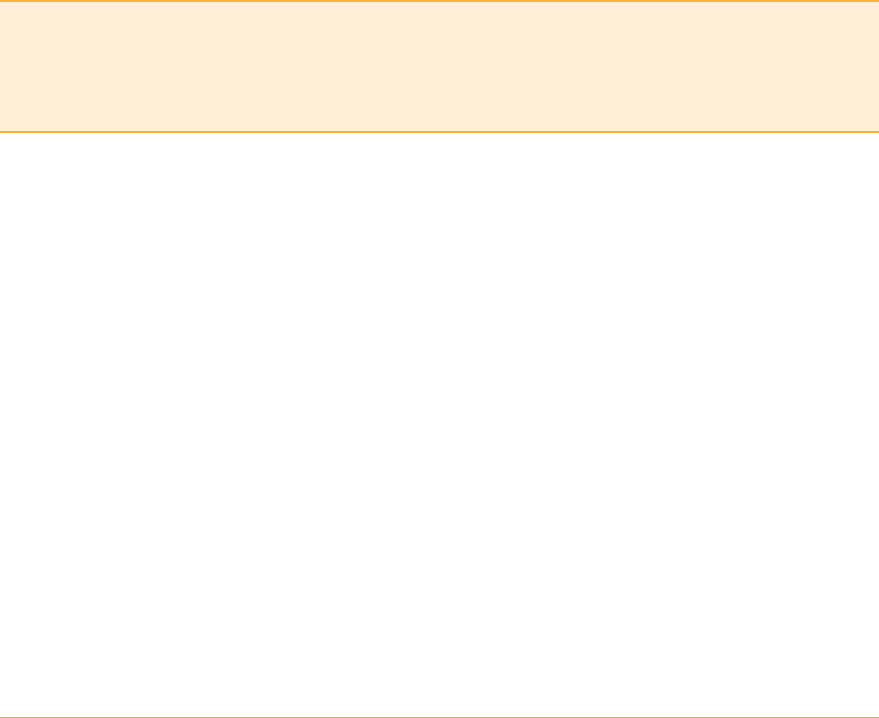
- 19 -
not in the position to play a role in the assessment of the situation at hand. Ground
Control has the full overview of the situation on the taxiways. The truck driver of the B747,
after checking the direct surroundings of the aircraft for obstacles, expected that
following the clearance given by Ground Control, there were no obstacles on the taxiway
behind the aircraft. As the pushback truck driver is not in direct contact with Ground
Control, he did not know that the B787 had received a long pushback clearance.
Following the long pushback of the B787, the ground controller was uncertain if there
was sufficient space for the second pushback and therefore issued a cautionary message
to the flight crew of the B747 regarding the longer pushback of the B787. The transmission
of the ground controller’s message to the flight crew of the B747 about the long pushback
was partially blocked out by another transmission. As a consequence the flight crew was
not able to inform the pushback truck driver.
The ground controller was unaware that this transmission was partially blocked by another
radio transmission. According to LVNL, a blocked transmission is not uncommon due to
the high number of radio transmissions at Schiphol. For the controller it is not always
possible to identify that a transmission was blocked. The ground controller did not
challenge the missing readback and acknowledgement of the cautionary message by the
flight crew of the B747. After the occurrence, the ground controller stated that he had
been aware that there was no readback, but he had not interpreted this as a sign that his
message was not heard by the flight crew.
Ground Control has the overview of the situation on the taxiways. The responsibility
for obstacle clearance on the taxiway cannot be shifted to the pushback truck driver.
For the controllers it is not always possible to identify a blocked radio transmission.
2�4 ISMS investigation results and follow-up actions
Following the pushback accident, the sector parties decided to conduct a joint
investigation within the context of the ISMS. The investigation team consisted of safety
experts from the different sector parties involved.
17
The ISMS investigation report was
finalized in November 2019 and identified the following safety issues:
• The clearance of a ‘long pushback’ is not an assessed and aligned procedure within
the sector parties;
• There is no structured approach in the training of ground controllers for an
undocumented pushback clearance;
• Challenging a missing acknowledgement on a ground movement clearance
instruction was absent. The absence of challenging a missing acknowledgement on a
ground movement clearance instruction, especially when separation between objects
is marginal, is considered a safety issue;
17 KLM, LVNL, AAS, Dutch Airline Pilots Association (VNV).

- 20 -
• The inability of always identifying a blocked radio transmission for Air Traffic Control
(ATC);
• Delegating the assessment of object separation on the apron by Ground Control to
the pushback truck driver.
In the ISMS investigation report a first set of potential risk reduction actions was listed.
On 20 May 2020 an operational instruction was issued within LVNL, announcing that:
• A pushback clearance shall only be given by a ground controller when the controller
has determined that the pushback does not conflict with other traffic.
• The ground controller shall not delegate the responsibility for separation to the
pushback truck driver.
• A ‘long pushback’ clearance is no longer to be used by Ground Control. Only
clearances with a specific end position shall be issued.
In addition, several awareness actions have been taken, e.g. introduction of an e-learning
module for ground controllers to improve awareness regarding the pushback truck
driver’s visual perspective.
Following discussion of the investigation report at an ISMS TOPSAG (Top Safety Action
Group) meeting, for decision making regarding the identified findings, safety issues and
risk categorisation, it was decided to create a dedicated taskforce (the Taskforce
Pushback) to address the identified safety issues and propose mitigation measures.
18
On
2 October 2020 the ISMS TOPSAG agreed on a set of further measures to be implemented
for the reduction of pushback collision risks. Planned are risk reduction actions in the
areas of procedural measures, infrastructure, communication, planning, system support
and awareness. The actions include:
• Provide for all non-standard pushback clearances an explicit direction and location to
end pushback.
• Study the use of a limited number of start-up points that supersede the current
pushback limit lines.
19
• Study the possibilities of direct communication between pushback driver and ATC.
• Study the technological solutions to enable ground controllers to recognize blocked
transmissions;
• Develop enhanced system support for Ground Control for the detection of conflict
situations;
• Analyse practicable solutions for the optimization of the planning cycle to reduce the
likelihood of simultaneous pushback movements in bays.
Overall, the ISMS investigation report presents a detailed and structured analysis of the
accident. The Board notes that following the accident, some risk mitigating measures
have already been implemented by the sector parties, such as that it has been emphasized
through an instruction to air traffic controllers that obstacle clearance assessment shall
not be delegated to pushback truck drivers.
18 The Taskforce studied the risk reduction actions which are identified by the ISMS investigation teams of the
pushback collisions of 13 February 2019 and 9 July 2019. This latter occurrence is also investigated by the Dutch
Safety Board. In addition to the already identified risk reduction actions, the Taskforce identified alternative risk
reduction actions based on expert judgement.
19 Start-up points are fixed points on the taxiway where aircraft can be positioned for engine start-up.

- 21 -
The undocumented long pushback procedure is an example of a working practice that is
not a standard procedure and that according to the ISMS investigation was not an
assessed and aligned procedure within the sector parties. In response to the accident,
the LVNL did amend the working practice. A ‘long pushback’ clearance is now only issued
with an indication of the position or reference for the end of the pushback. The deviation
from the standard procedures continues to exist as working practice, still adding
complexity and introducing risks (for pushbacks the risk of collision) as non-standard
procedures are not assessed for safety risks.
In October 2020, ISMS TOPSAG agreed on additional actions to further reduce the risk
of collision. The majority of these actions for the introduction of new safety measures are
actions that require further study and/or involve future technological developments. It is
therefore still uncertain if these measures will be implemented and in how far these
measures will contribute to further pushback collision risk reduction.
The ISMS investigation has identified relevant safety issues. The long pushback
procedure has been amended and only clearances with a specific end position shall
be issued by the ground controller. It is uncertain to what extent a set of additionally
identified safety measures will contribute to a further risk reduction of pushback
collisions, as for the majority of these measures further study or technological
development is needed.
2�5 CVR recordings
The CVR recordings of the B787 covering the accident were unavailable. The Board
emphasizes the importance of CVR data to establish facts as part of an air safety
investigation into the cause of an occurrence. In case of an accident, the operator and
flight crew should act accordingly and do – in accordance with Regulation (EU) No
965/2012 on Air Operations - the utmost to ensure the CVR recordings are preserved for
the purpose of the safety investigation. For this specific occurrence, the accident
occurred at the home base of the operator with sufficient time and opportunity to secure
the recorder data by the operator.
20
The European regulations regarding the duration of the CVR recordings have been
amended to ensure that CVRs will be capable of recording the preceding 25 hours
instead of 2 hours. However, as this requirement only applies to aeroplanes with a
certificate of airworthiness on or after 1 January 2022, it will take years before this is
implemented across the existing commercial air transport fleet.
20 At the time of this report, the Dutch Safety Board is conducting two other investigations where the CVR-recordings
are not available. Also in the report ‘Take-off from Taxiway’ published in 2011, the Dutch Safety Board noted that
the absence of CVR data for the purpose of the investigation a great deficiency.

- 22 -
This investigation shows that the operator’s procedures were not effective in
preserving the CVR recordings, which is an obligation in case of an accident or
serious incident.

- 23 -
3 CONCLUSIONS
During pushback, a B747 collided with a B787 standing on the taxiway before taxiing out.
The separation between the aircraft was insufficient due to a long pushback of the B787,
beyond the pushback limit line.
The undocumented long pushback procedure was not an assessed and aligned
procedure within the sector parties at Schiphol. As a result of the long pushback of the
B787 separation margins were no longer ensured. The reason for deviating from the
standard pushback procedure was to ensure an efficient flow of traffic. Deviating from
the standard procedures is not an uncommon practice for air traffic controllers at
Schiphol, as was also noted in the Dutch Safety Board’s 2017 Schiphol investigation. In
order to deal with specific or complex situations, controllers need some professional
space to, if necessary, deviate from standard procedures. However, deviating from
standards and routines can also lead to additional complexity without overseeing all
consequences.
The assessment of the taxiway behind the aircraft and the issuance of conflict-free
pushback clearances is the responsibility of Ground Control and cannot be delegated to
a pushback truck driver. The use of standard pushback procedures with known obstacle
clearances and separation margins is the main barrier to ensure sufficient separation in
pushback operations. It is therefore essential that in case of deviations from the standard
procedure, the risks are recognized and acted upon. Where choices can be made, safety
should have priority over efficiency. This may imply that temporary traffic restrictions
apply.
Following the accident, the Air Traffic Control procedures have been amended to clarify
the responsibilities of Ground Control and to include a specific position or reference for
non-standard pushback clearances. Although this provides more clarity for both ground
controller and pushback truck driver, the working practice of long pushback procedures
whereby separation margins are not guaranteed, is still being used and thereby
introducing complexities and safety risks as it is not an assessed procedure. It is uncertain
to what extent a set of additional safety measures initiated by the sector parties will
contribute to a further risk reduction of pushback collisions, as the majority of these
measures require further study or technological development before implementation.
The investigation further showed that the operator’s procedures were not effective in
preserving the Cockpit Voice Recorder (CVR) recordings for the purpose of the safety
investigation, which is an obligation in the event of an accident or serious incident.

- 24 -
APPENDIX A
Responses to the draft report
In accordance with the Dutch Safety Board Act, a draft version of this report was
submitted to the parties directly involved for review. The following parties have been
requested to check the report for any factual inaccuracies and ambiguities:
• Ground controller
• Air Traffic Control the Netherlands (LVNL)
• Pushback truck drivers
• KLM Royal Dutch Airlines
• Amsterdam Airport Schiphol (AAS)
• Dutch Ministry of Infrastructure and Water Management
• European Union Aviation Safety Agency (EASA)
The responses received, as well as the way in which they were processed, are set out in a
table that can be found on the Dutch Safety Board’s website (www.safetyboard.nl).
The responses received can be divided into the following categories:
• Corrections and factual inaccuracies, additional details and editorial comments that
were taken over by the Dutch Safety Board (insofar as correct and relevant). The
relevant passages were amended in the final report.
• Responses that were not adopted by the Dutch Safety Board. The reason for this
decision is explained in the table.

DUTCH
SAFETY BOARD
Visiting address
Lange Voorhout 9
2514 EA The Hague
The Netherlands
T +31 70 333 70 00
F +31 70 333 70 77
Postal address
PO Box 95404
2509 CK The Hague
The Netherlands
www.safetyboard.nl
